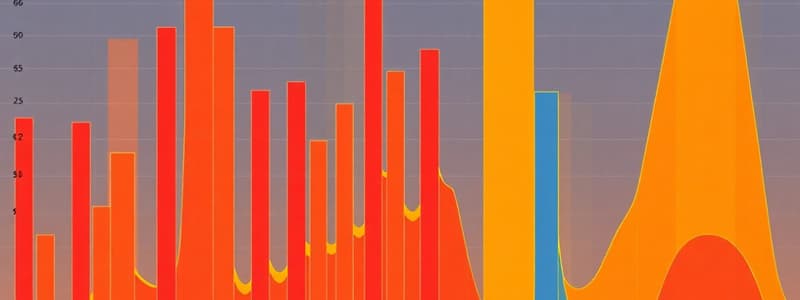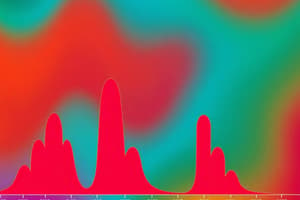Podcast
Questions and Answers
What is the frequency of farmers with a weight of 60 kg?
What is the frequency of farmers with a weight of 60 kg?
- 4 (correct)
- 2
- 6
- 1
What is the total number of farmers in the sample?
What is the total number of farmers in the sample?
- 20
- 24
- 22
- 18 (correct)
How many household heads weigh between 56 kg and 60 kg?
How many household heads weigh between 56 kg and 60 kg?
- 6
- 3 (correct)
- 9
- 15
What is the main disadvantage mentioned in the text regarding the ungrouped frequency distribution?
What is the main disadvantage mentioned in the text regarding the ungrouped frequency distribution?
What is the cumulative frequency at the end of the class interval 64 - 68 kg?
What is the cumulative frequency at the end of the class interval 64 - 68 kg?
What is the class boundary at the upper end of the class interval 60 - 64 kg?
What is the class boundary at the upper end of the class interval 60 - 64 kg?
What is the purpose of grouping observations into categories in a grouped frequency distribution?
What is the purpose of grouping observations into categories in a grouped frequency distribution?
What is the main difference between an ungrouped and grouped frequency distribution?
What is the main difference between an ungrouped and grouped frequency distribution?
What is the class width of the class interval 52 - 55 kg?
What is the class width of the class interval 52 - 55 kg?
What is the term used for each category in a grouped frequency distribution?
What is the term used for each category in a grouped frequency distribution?
Which of these options describes the Tally Score Method?
Which of these options describes the Tally Score Method?
What is the main aim of a farm survey, according to the text?
What is the main aim of a farm survey, according to the text?
How does the Tally Score Method help in data analysis?
How does the Tally Score Method help in data analysis?
Why is it important to organize raw data?
Why is it important to organize raw data?
What is the purpose of creating an array from raw data?
What is the purpose of creating an array from raw data?
From the given data, what is the highest weight recorded for the heads of the households?
From the given data, what is the highest weight recorded for the heads of the households?
What is the name given to the type of frequency distribution used when the data is organized into classes?
What is the name given to the type of frequency distribution used when the data is organized into classes?
Which of these is NOT a characteristic of raw data?
Which of these is NOT a characteristic of raw data?
What is the purpose of a frequency distribution?
What is the purpose of a frequency distribution?
What is the difference between ungrouped and grouped frequency distributions?
What is the difference between ungrouped and grouped frequency distributions?
What is the relative frequency of girls in the 16-17 age group?
What is the relative frequency of girls in the 16-17 age group?
Which age group has the largest difference in relative frequency between boys and girls?
Which age group has the largest difference in relative frequency between boys and girls?
What does the data suggest about the proportion of students in the 14-15 age group?
What does the data suggest about the proportion of students in the 14-15 age group?
What percentage of household heads weigh less than 53 kg?
What percentage of household heads weigh less than 53 kg?
What is the cumulative frequency of household heads weighing between 60 and 67 kg?
What is the cumulative frequency of household heads weighing between 60 and 67 kg?
If 50 households were surveyed, how many would be expected to have heads weighing 64kg or more?
If 50 households were surveyed, how many would be expected to have heads weighing 64kg or more?
What is the percentage of household heads weighing more than 71 kg?
What is the percentage of household heads weighing more than 71 kg?
What is the lower boundary of the weight class 72-75 kg?
What is the lower boundary of the weight class 72-75 kg?
What is the relative frequency of farmers weighing between 64 and 67 kg?
What is the relative frequency of farmers weighing between 64 and 67 kg?
What is the class width for the weight class 64 - 67 kg?
What is the class width for the weight class 64 - 67 kg?
How many farmers weigh between 68 and 71 kg?
How many farmers weigh between 68 and 71 kg?
What is the total number of farmers represented in the table?
What is the total number of farmers represented in the table?
What is the relative frequency of farmers weighing less than 64 kg?
What is the relative frequency of farmers weighing less than 64 kg?
Which weight class has the highest relative frequency?
Which weight class has the highest relative frequency?
What is the difference in relative frequency between the heaviest and lightest weight classes?
What is the difference in relative frequency between the heaviest and lightest weight classes?
What is the relative frequency of farmers weighing 60 kg or more?
What is the relative frequency of farmers weighing 60 kg or more?
What is the approximate number of classes recommended by Sturge's Rule for a sample size of 100?
What is the approximate number of classes recommended by Sturge's Rule for a sample size of 100?
Flashcards
Sturge’s Rule
Sturge’s Rule
A guideline to determine the number of classes (k) based on sample size (n). k = 1 + 3.322 log10(n).
Class Width (i)
Class Width (i)
The width of each class in a frequency distribution, calculated as Range divided by number of classes (k).
Range
Range
The difference between the highest and lowest values in a dataset.
Relative Frequency
Relative Frequency
Signup and view all the flashcards
Class Frequency
Class Frequency
Signup and view all the flashcards
Frequency Distribution
Frequency Distribution
Signup and view all the flashcards
Class Boundaries
Class Boundaries
Signup and view all the flashcards
Tally Marks
Tally Marks
Signup and view all the flashcards
Percentage Calculation
Percentage Calculation
Signup and view all the flashcards
Comparison of Frequencies
Comparison of Frequencies
Signup and view all the flashcards
Population Sample
Population Sample
Signup and view all the flashcards
Data Normalization
Data Normalization
Signup and view all the flashcards
Frequency
Frequency
Signup and view all the flashcards
Un-grouped Frequency Distribution
Un-grouped Frequency Distribution
Signup and view all the flashcards
Grouped Frequency Distribution
Grouped Frequency Distribution
Signup and view all the flashcards
Class Interval
Class Interval
Signup and view all the flashcards
Tally Score Method
Tally Score Method
Signup and view all the flashcards
Most Common Weight
Most Common Weight
Signup and view all the flashcards
Cumbersome Data
Cumbersome Data
Signup and view all the flashcards
Household Head Weight Frequency
Household Head Weight Frequency
Signup and view all the flashcards
Household heads < 52 kg
Household heads < 52 kg
Signup and view all the flashcards
Household heads > 52 kg
Household heads > 52 kg
Signup and view all the flashcards
Cumulative frequency for < 56 kg
Cumulative frequency for < 56 kg
Signup and view all the flashcards
Cumulative frequency for < 60 kg
Cumulative frequency for < 60 kg
Signup and view all the flashcards
Cumulative frequency for < 76 kg
Cumulative frequency for < 76 kg
Signup and view all the flashcards
Descriptive Statistics
Descriptive Statistics
Signup and view all the flashcards
Population of Interest
Population of Interest
Signup and view all the flashcards
Raw Data
Raw Data
Signup and view all the flashcards
Array
Array
Signup and view all the flashcards
Grouped Data
Grouped Data
Signup and view all the flashcards
Ungrouped Distribution
Ungrouped Distribution
Signup and view all the flashcards
Frequency Table
Frequency Table
Signup and view all the flashcards
Cumulative Frequency Distribution
Cumulative Frequency Distribution
Signup and view all the flashcards
Age Group Comparison
Age Group Comparison
Signup and view all the flashcards
Proportional Distribution
Proportional Distribution
Signup and view all the flashcards
Bias in Education
Bias in Education
Signup and view all the flashcards
Weight Class Tally
Weight Class Tally
Signup and view all the flashcards
Difference in Distribution
Difference in Distribution
Signup and view all the flashcards
Study Notes
Descriptive Statistics: Data Presentation
-
Data description is a critical first step in statistical analysis. The goal is to understand and characterize the population of interest. This might involve assessing crop output, consumer product consumption, or the prevalence of a condition.
-
Data organization is essential for drawing meaningful insights. Raw data, as collected from the field, offers limited information.
-
A key method for organizing data is the array. This involves arranging data values in ascending or descending order.
-
A frequency distribution table (ungrouped) is a method to present data counts for specific values. The raw data is organized in this manner, showing how many times each unique value appears in the sample.
-
A grouped frequency distribution is advantageous for large datasets. This method uses pre-defined intervals (class intervals or classes) to categorize the data, making it easier to analyze patterns and trends.
-
Class limits are the end values of each class interval.
-
Class boundaries are numbers used to delineate the classes without gaps in the frequency distribution. They create a smooth transition between classes.
-
Class size (class width) is the difference between the upper and lower class boundaries of a class.
-
Class mark (midpoint) of a class interval is found by averaging the upper and lower limits of a class interval.
-
Frequency is the number of times a particular value or data point occurs within a class interval.
-
Relative frequency is the proportion of a data point in a particular class or interval to the total number of data points. It's calculated by dividing a class's frequency by the total frequency, expressed as a percentage.
-
A cumulative frequency is the sum of the frequencies of all classes up to a certain point. It shows the total frequency of values which are at or below a given value or limit.
-
Cumulative frequency distributions help in answering questions about how many data points fall below a particular value, or above a certain value.
Studying That Suits You
Use AI to generate personalized quizzes and flashcards to suit your learning preferences.




